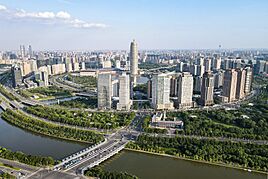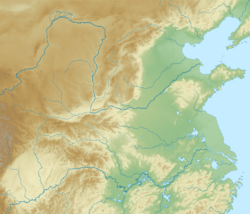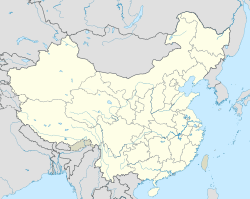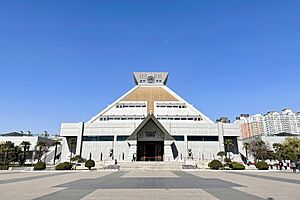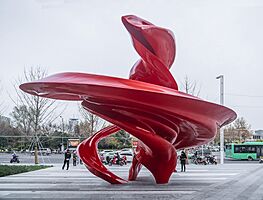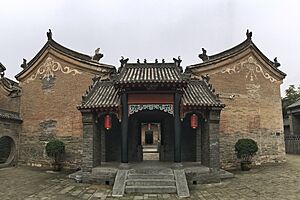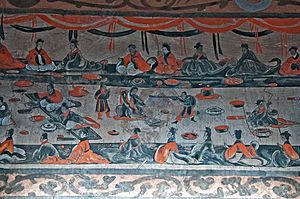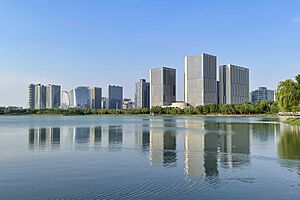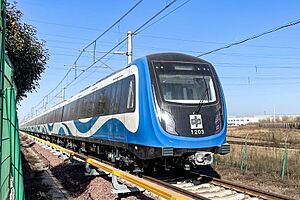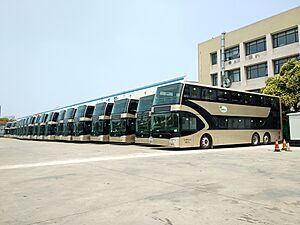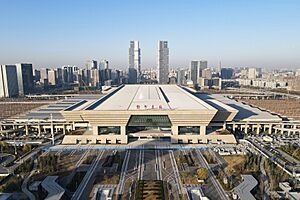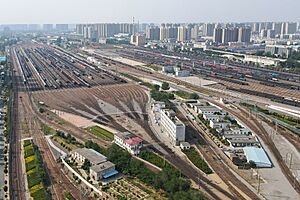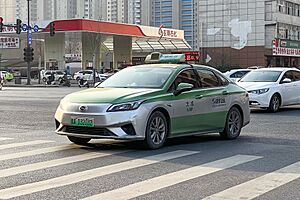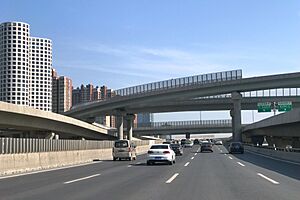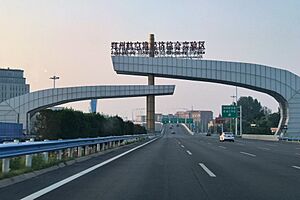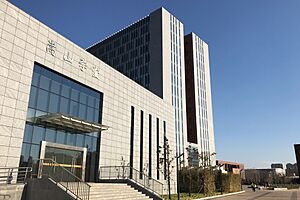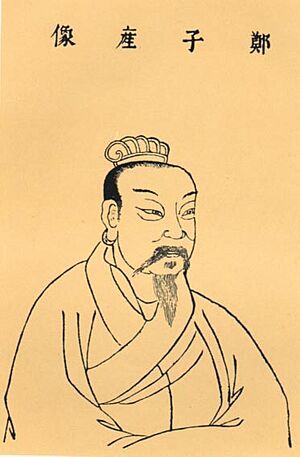Zhengzhou facts for kids
Quick facts for kids
Zhengzhou
郑州市
Chengchow
|
|
|---|---|
|
Prefecture-level city
|
|
|
Zhengdong New Area CBD
Erqi Square
Greenland Central Plaza
Pagoda Forest
Emperors Yan and Huang
Zhengzhou City God Temple
|
|
| Nickname(s):
business city, green city
|
|
| Motto(s):
Partnership, Openness, Innovation, and Harmony (博大、开放、创新、和谐)
|
|
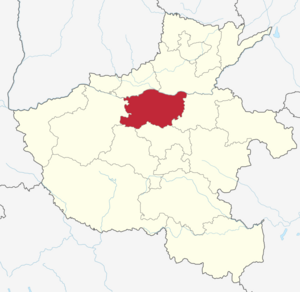
Location of Zhengzhou City; jurisdiction in Henan
|
|
| Country | China |
| Province | Henan |
| Established | 16th century BCE |
| City seat | Zhongyuan |
| Subdivisions |
List
Districts
Erqi Guancheng Hui Huiji Jinshui Shangjie Zhongyuan County-level cities Dengfeng Gongyi Xingyang Xinmi Xinzheng County Zhongmu |
| Government | |
| • Type | Prefecture-level city |
| • Body | Zhengzhou Municipal People's Congress |
| Area | |
| • Prefecture-level city | 7,567 km2 (2,922 sq mi) |
| • Urban | 1,284.89 km2 (496.10 sq mi) |
| • Metro | 4,271.4 km2 (1,649.2 sq mi) |
| Population
(2020 census)
|
|
| • Prefecture-level city | 12,600,574 |
| • Density | 1,665.20/km2 (4,312.85/sq mi) |
| • Urban | 6,650,532 |
| • Urban density | 5,175.954/km2 (13,405.66/sq mi) |
| • Metro | 10,260,667 |
| • Metro density | 2,402.179/km2 (6,221.61/sq mi) |
| GDP | |
| • Prefecture-level city | CN¥ 1,361 trillion US$ 193 billion |
| • Per capita | CN¥ 104,754 US$ 14,866 |
| Time zone | UTC+8 (China Standard) |
| Postal code |
450000
|
| Area code(s) | 371 |
| ISO 3166 code | CN-HA-01 |
| License plate prefixes | 豫A 豫V |
| Zhengzhou | |||||||||||||||||||||||||||
|---|---|---|---|---|---|---|---|---|---|---|---|---|---|---|---|---|---|---|---|---|---|---|---|---|---|---|---|

"Zhèngzhōu" in Simplified (top) and Traditional (bottom) Chinese characters
|
|||||||||||||||||||||||||||
| Simplified Chinese | 郑州 | ||||||||||||||||||||||||||
| Traditional Chinese | 鄭州 | ||||||||||||||||||||||||||
| Literal meaning | "Zhèng Settlement" | ||||||||||||||||||||||||||
|
|||||||||||||||||||||||||||
Zhengzhou{{efn|/dʒɛŋˈdʒoʊ, dʒʌŋ-/, JENG-joh-,_-jung-; simplified Chinese: 郑州; traditional Chinese: 鄭州; pinyin: Zhèngzhōu), also called Chengchow, is the capital city of Henan province in China. It's located in northern Henan and is one of China's nine important "national central cities." This means it's a major hub for politics, economy, technology, and education in the province. The larger Zhengzhou area, which includes Kaifeng, is a key part of the Central Plains Economic Zone.
The city sits on the southern side of the Yellow River. Zhengzhou is a big center for transportation in China and connects to other countries, even Europe. It also has an international airport. Zhengzhou is known as a "National Civilized City" and a "State-list Famous Historical and Culture City." As of 2020, two of its sites are recognized as World Cultural Heritage Sites. The Zhengzhou Commodity Exchange (ZCE) was China's very first futures exchange. The Zhengzhou Airport Economy Zone was also the first of its kind in China.
In 2020, Zhengzhou had over 12.6 million people. More than 10 million of these people lived in the main city area, which includes 6 urban districts and nearby areas like Zhongmu county, Xinzheng, and Xingyang cities. In 2018, the city's total economic output (GDP) was about 1.014 trillion Chinese Yuan. In 2012, Zhengzhou was named one of China's 13 "emerging mega-cities." In 2017, the government officially named it the eighth "National Central City."
Zhengzhou is also a big city for science. It's among the top 100 cities globally for scientific research, according to the Nature Index. The city has several important universities, including Zhengzhou University, Henan University, Henan Agricultural University, Henan University of Chinese Medicine, and Henan University of Technology.
History of Zhengzhou
The Shang dynasty built a city called Aodu or Bodu in the Zhengzhou area. This ancient city was abandoned long before 260 BC. Since the 1950s, archaeologists have found evidence of Shang dynasty settlements from around 1600 BC in a walled city in Eastern Zhengzhou. Outside this city, they found remains of large public buildings and smaller settlements. This site is believed to be Ao, an ancient Shang capital, and is now a monument in Guanchen District.
The Shang rulers often moved their capital because of natural disasters. They left Ao around 13th century BC. However, people continued to live there. Tombs from the Zhou dynasty (after 1050 BC) have also been found. Legend says that during the Western Zhou period (1111–771 BC), the area became a special land for a family named Guan. This is where the name Guancheng (City of the Guan) comes from, used since the late 6th century BC. The city first became a local government center in AD 587, when it was called Guanzhou. In 605, it was first named Zhengzhou, a name it has kept almost ever since.
The name Zhengzhou came from the Sui dynasty (AD 582), even though the government was in a different town called Chenggao at that time. The government moved to the current city during the Tang dynasty. Zhengzhou became very important during the Sui (AD 581–618), Tang (618–907), and early Song (960–1127) periods. It was the end point of the New Bian Canal, which connected the Yellow River to the northwest. A huge storage area for grain was built there to supply the capitals at Luoyang and Chang'an and the armies. But during the Song period, the capital moved to Kaifeng, and Zhengzhou became less important.
In 1903, the Beijing–Hankou Railway reached Zhengzhou. In 1909, the first part of the Longhai Railway connected it to Kaifeng and Luoyang. This railway was later extended to the coast and to Xi'an. Zhengzhou then became a major railway hub. It was also a regional center for crops like cotton, grain, and peanuts. In 1923, a workers' strike started in Zhengzhou and spread along the railway. A 14-story tower in the city center remembers this event. In 1938, during the Second Sino-Japanese War, the Yellow River dikes were opened near Zhengzhou to stop the invading Japanese. This caused a huge flood, which also affected many Chinese people.
Zhengzhou also has factories that repair locomotives and train cars. There are also plants that assemble tractors and a power station. The city's growth has led to a big increase in population, mostly from industrial workers. A water project built in 1972 helps irrigate the farms around the city. Zhengzhou also has an agricultural university. In July 2021, heavy floods caused by record rainfall displaced over a million people and led to the deaths of at least 300 people.
Geography and Climate
Zhengzhou is located just north of the center of Henan province and south of the Yellow River. It shares borders with Luoyang to the west, Jiaozuo to the northwest, Xinxiang to the northeast, Kaifeng to the east, Xuchang to the southeast, and Pingdingshan to the southwest. The land in Zhengzhou generally slopes down from west to east. It's in the area where the North China Plain (to the east) meets the Song Mountains and Xionger Mountains (to the west). These mountains are part of the larger Qinling range. The city center is south of the Yellow River, where its valley widens into a large plain. Zhengzhou is also at a key crossing point for routes that go around the Taihang Mountains and the mountains of western Henan. The city covers a total area of about 7,567 square kilometers (2,922 sq mi).

A part of the Yellow River flows along the northern edge of the city area for about 150.4 kilometers (93.5 mi). However, the Jialu River, which is a smaller river that flows into the Huai River, is Zhengzhou's main city river and helps with flood control. The Jialu River enters Zhengzhou from Xinmi in the southwest and then turns southeast within the city. Mountains are found in the western counties of Gongyi and Dengfeng. The easternmost county, Zhongmu, is a large, fertile flat area. The counties in between have hilly landscapes.
Zhengzhou's Climate
Zhengzhou has a humid subtropical climate with four seasons. This means it has cool, dry winters and hot, humid summers. Spring and autumn are short and dry transition times. The average yearly temperature in Zhengzhou is 15.4°C (59.7°F). The average monthly temperature ranges from 1.0°C (33.8°F) in January to 27.8°C (82.0°F) in July. The city usually has about 220 days without frost. The coldest temperature recorded since 1951 was -17.9°C (-0.2°F), and the hottest was 43.0°C (109.4°F).
Most of the rain falls during the summer because of the East Asian monsoon. In winter, the area gets very little rain. During summer, tropical storms can also bring more rain. The city gets about 630 millimeters (25 inches) of rain each year. Zhengzhou gets about 1,905 hours of sunshine per year, which is about 43% of the total possible sunshine.
| Climate data for Zhengzhou (1991–2020 normals, extremes 1951–present) | |||||||||||||
|---|---|---|---|---|---|---|---|---|---|---|---|---|---|
| Month | Jan | Feb | Mar | Apr | May | Jun | Jul | Aug | Sep | Oct | Nov | Dec | Year |
| Record high °C (°F) | 21.0 (69.8) |
25.2 (77.4) |
29.2 (84.6) |
37.2 (99.0) |
38.5 (101.3) |
42.3 (108.1) |
43.0 (109.4) |
40.1 (104.2) |
38.1 (100.6) |
34.6 (94.3) |
27.0 (80.6) |
25.6 (78.1) |
43.0 (109.4) |
| Mean daily maximum °C (°F) | 6.1 (43.0) |
10.0 (50.0) |
15.9 (60.6) |
22.6 (72.7) |
27.9 (82.2) |
32.2 (90.0) |
32.4 (90.3) |
30.8 (87.4) |
27.1 (80.8) |
21.8 (71.2) |
14.6 (58.3) |
8.2 (46.8) |
20.8 (69.4) |
| Daily mean °C (°F) | 1.0 (33.8) |
4.3 (39.7) |
10.1 (50.2) |
16.6 (61.9) |
22.3 (72.1) |
26.7 (80.1) |
27.8 (82.0) |
26.4 (79.5) |
21.8 (71.2) |
16.1 (61.0) |
8.9 (48.0) |
3.1 (37.6) |
15.4 (59.8) |
| Mean daily minimum °C (°F) | −3 (27) |
−0.3 (31.5) |
4.9 (40.8) |
10.8 (51.4) |
16.5 (61.7) |
21.3 (70.3) |
23.8 (74.8) |
22.6 (72.7) |
17.4 (63.3) |
11.4 (52.5) |
4.4 (39.9) |
−1.1 (30.0) |
10.7 (51.3) |
| Record low °C (°F) | −17.9 (−0.2) |
−17.9 (−0.2) |
−7.5 (18.5) |
−1.4 (29.5) |
3.1 (37.6) |
10.3 (50.5) |
15.1 (59.2) |
13.2 (55.8) |
5.0 (41.0) |
−1.5 (29.3) |
−13.1 (8.4) |
−17.9 (−0.2) |
−17.9 (−0.2) |
| Average precipitation mm (inches) | 10.1 (0.40) |
12.8 (0.50) |
19.3 (0.76) |
37.0 (1.46) |
58.1 (2.29) |
65.1 (2.56) |
139.1 (5.48) |
137.4 (5.41) |
78.2 (3.08) |
38.9 (1.53) |
27.2 (1.07) |
8.1 (0.32) |
631.3 (24.86) |
| Average precipitation days (≥ 0.1 mm) | 3.8 | 4.1 | 5.3 | 5.7 | 6.5 | 7.3 | 10.8 | 10.3 | 8.5 | 6.3 | 5.4 | 3.3 | 77.3 |
| Average snowy days | 4.2 | 3.3 | 1.6 | 0.2 | 0 | 0 | 0 | 0 | 0 | 0 | 1.2 | 2.8 | 13.3 |
| Average relative humidity (%) | 57 | 57 | 54 | 57 | 57 | 58 | 73 | 76 | 71 | 65 | 62 | 56 | 62 |
| Mean monthly sunshine hours | 117.0 | 128.2 | 167.9 | 194.5 | 211.8 | 195.9 | 166.1 | 163.1 | 147.3 | 148.9 | 136.4 | 127.6 | 1,904.7 |
| Percent possible sunshine | 37 | 41 | 45 | 49 | 49 | 45 | 38 | 40 | 40 | 43 | 44 | 42 | 43 |
| Source 1: China Meteorological Administration | |||||||||||||
| Source 2: Weather China | |||||||||||||
In 2019, Zhengzhou had 177 "good days" for air quality. This was 9 more days than the year before. About 48.5% of these days met the air quality standards. There were 24 days with heavy pollution, which was 9 fewer than the previous year.
2021 Floods in Zhengzhou
On July 20, 2021, Zhengzhou experienced the heaviest hour of rainfall ever recorded in China. This caused severe floods, and at least 300 people died, including 14 who drowned in a subway tunnel. Even though an emergency alert was sent out the day before, businesses and subways stayed open. From 4 PM to 5 PM on July 21, 7.95 inches of rain fell. A wall collapsed, letting water flood into subway tunnels. The Chinese government has since recognized that local officials made mistakes and that severe weather events might happen more often.
City Administration and Population
Zhengzhou is divided into 6 urban districts, 5 county-level cities, and 1 county. These divisions might change in the future as the city grows quickly.
The city is home to over 8.6 million people (2010 census). About 6.35 million live in the main city area, which includes 6 urban and suburban districts. Xingyang, Xinzheng, and Zhongmu county are now largely part of the urban area. This makes Zhengzhou one of the biggest urban areas in the province.
| Map | |||||
|---|---|---|---|---|---|

Jinshui
Erqi
Huiji
Guancheng
Zhongyuan
Shangjie
Xingyang
(city) Xinzheng
(city) Dengfeng
(city) Xinmi
(city) Gongyi
(city) Zhongmu
County |
|||||
| Name | Simplified Chinese | Hanyu Pinyin | Population (2010) |
Area (km2) | |
| City proper | |||||
| Jinshui District | 金水区 | Jīnshuǐ Qū | 1,588,611 | 242 | |
| Erqi District | 二七区 | Èrqī Qū | 712,597 | 159 | |
| Huiji District | 惠济区 | Hùijì Qū | 269,561 | 206 | |
| Guancheng Hui District | 管城回族区 | Guǎnchéng Huízú Qū | 645,888 | 204 | |
| Zhongyuan District | 中原区 | zhōngyuán Qū | 905,430 | 195 | |
| Suburban | |||||
| Shangjie District | 上街区 | Shàngjiē Qū | 131,540 | 64.7 | |
| Satellite cities | |||||
| Xingyang | 荥阳市 | xíngyáng Shì | 613,761 | 908 | |
| Xinzheng | 新郑市 | Xīnzhèng Shì | 758,079 | 873 | |
| Dengfeng | 登封市 | Dēngfēng Shì | 668,592 | 1220 | |
| Xinmi | 新密市 | Xīnmí Shì | 797,200 | 1001 | |
| Gongyi | 巩义市 | Gǒngyì Shì | 807,857 | 1041 | |
| Rural | |||||
| Zhongmu County | 中牟县 | Zhōngmù Xiàn | 727,389 | 1393 | |
Main Sights and Attractions
Zhengzhou was once the capital of China during the Shang dynasty. You can still see parts of the Shang-era city wall, built 3,600 years ago, in Downtown Zhengzhou. This is known as Zhengzhou Shang City. Zhengzhou has many cultural sites that show its long history and the culture of Henan Province. The Zhengzhou Confucius Temple, built 1900 years ago, is one of the oldest Confucian Temples in China. Other important historical buildings in the city center include the Town God Temple and the Erqi Memorial Tower.
A famous place to visit is the Shaolin Monastery (少林寺). It's in Dengfeng, about 90 kilometers (56 mi) southwest of downtown Zhengzhou. The Shaolin Monastery is known as an important Buddhist temple and the ancient home of Chinese Kung-fu. The Shaolin Monastery and its famous Pagoda Forest became a UNESCO World Heritage Site in 2010.
The Henan Museum is one of China's most important museums. It has over 130,000 cultural items. These include exhibits from prehistoric times, like dinosaur fossils and ancient human remains, all the way to modern times.
The newest and most modern part of Zhengzhou is the Zhengdong New Area, in the eastern part of the city. It has some of Zhengzhou's tallest skyscrapers. These include the 280-meter (919 ft) tall Zhengzhou Greenland Plaza (nicknamed "Big Corn"), which is a famous landmark. The twin towers of Zhengzhou Greenland Central Plaza are 285 meters (935 ft) tall and are currently the tallest skyscrapers in the city. The tallest building in Zhengzhou is the 388-meter (1,273 ft) tall Zhongyuan Tower. It's a television tower with a revolving restaurant and an observation deck. This tower is among the tallest towers in the world.
The Zhengzhou Zoo (郑州动物园) is on Huayuan Road (花园路). The new Zhengzhou Botanic Garden is on the western edge of Zhengzhou city.
Main attractions of Zhengzhou include:
- Mount Song (UNESCO Global Geopark)
- Shaolin Monastery and Pagoda Forest (UNESCO World Heritage Site)
- Dengfeng Observatory (UNESCO World Heritage Site)
- Songyue Pagoda (UNESCO World Heritage Site)
- Yellow River Scenic Area
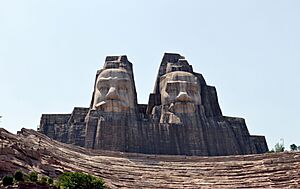
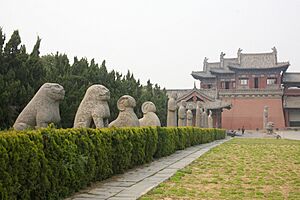
- Kang Baiwan's Mansion
- The birthplace of Yellow Emperor
- Erqi Memorial Tower
- Henan Museum
- Zhongyuan Tower
- Zhengzhou Shang City
Economy and Industry
Zhengzhou is one of the most important economic cities in inland China, similar to Xi'an, Chengdu, Chongqing, and Wuhan. It is the economic center for Henan province and nearby areas like southeastern Shanxi and southwestern Shandong. Zhengzhou is in a great location, in one of the most populated areas in the world (Henan alone has almost 100 million people). It's also a major hub for China's railway, road, and air transport. Because of this, Zhengzhou is attracting more and more money from within China and from other countries. It's also attracting people from other areas, making it one of China's biggest economic centers. In 2018, Zhengzhou's total economic output (GDP) was ¥1020 billion. By 2021, it grew to ¥1269.1 billion, ranking 16th in China.
Farming and Food Production
By the end of 2006, Zhengzhou had over 7 million people, with 2.88 million living in rural areas. The main crops grown here include apples, paulownia trees, tobacco, maize (corn), cotton, and wheat. Zhengzhou also produces special local foods. These include Yellow River carp fish, Zhengzhou watermelons, Xinzheng jujube (a type of date), Xingyang dried persimmons, Guangwu Pomegranates, and Zhongmu garlic. These are unique to the region.
Mining and Manufacturing
Zhengzhou and the areas around it have large amounts of coal and other minerals. Coal mining and producing electricity have always been important parts of the local economy.
Zhengzhou has been a major industrial city in China since 1949. The city's main industry is textiles (making cloth and clothes). Other things made here include tractors, locomotives, cigarettes, fertilizer, processed meats, agricultural machinery, and electrical equipment. In recent years, high-tech companies in new materials, electronics, and biotechnology are also growing fast. Many of these are in the high-tech industrial park in the northwest of the city.
- Yutong is China's largest bus maker.
- Shaolin Bus makes well-known small and medium-sized buses.
- Zhengzhou Nissan is part of Dongfeng Nissan. It specializes in making SUVs and pickup trucks. In 2010, Nissan opened its second factory in the city.
- Haima Automobile Zhengzhou makes microvans and light passenger vehicles.
- Zhengzhou Unique Industrial Equipment Co., Ltd. is a big maker of tractors and farm equipment.
- Foxconn Zhengzhou, located in the Zhengzhou Airport Economy Zone, is the largest smartphone production site in the world. It is also known as "iPhone City."
- Sanquan Food is a frozen food company. With over 20,000 employees, Sanquan made the first frozen dumplings and rice balls in China.
- Synear Food Holdings Limited, along with Sanquan Food, is one of the biggest frozen food producers in China. They have over 20% of the market share in China.
Services Sector
Zhengzhou's service industries include retail (shops), wholesale (selling to businesses), hospitality (hotels and restaurants), finance (banking), exhibitions, transport and delivery, tourism, and education. Many Chinese and international companies have offices here, making Zhengzhou a growing financial center in central China. The Zhengzhou Commodity Exchange (ZCE) is one of only four futures exchanges in China. It is becoming an important global player, especially for trading agricultural futures. Zhengzhou also has new facilities like the Zhengzhou International Conference and Exhibition Center. Logistics (moving goods) has also grown a lot in Zhengzhou recently. As a travel and tourist center for Henan Province, Zhengzhou is also a hub for Henan cuisine (food).
- Dennis is a regional chain of stores.
- Henan Jianye is a large real estate company that owns the China Super League football club Henan Jianye F.C..
Economic Development Zones
The Zhengdong New Area (Chinese: 郑东新区), which means "Eastern Zhengzhou New Area," is one of many large economic zones being built in China. It was started in 2003 by the local governments. It has become the financial center of Henan province and one of the fastest-growing areas in China.
Kisho Kurokawa, a famous Japanese planner and architect, designed the overall plan for Zhengdong New Area. He included modern ideas like ecological cities, co-existing cities, and ring cities. His plan won an award in 2002. Zhengdong New Area includes a central business district (CBD), the Longhu commercial and residential area, the Longzihu college area, and the Zhengzhou East railway station commercial area.
Industrial Zones
- Zhengzhou New & Hi-Tech Industries Development Zone
This zone was created in 1988 and approved by the government in 1991. It has been recognized as an advanced high-tech zone in China multiple times. The zone covers about 18.6 square kilometers (7.2 sq mi). An expansion plan was approved in 2004. The zone focuses on developing software, information technologies, new materials, bio-pharmaceuticals, and photo-machinery-electronic industries.
- Zhengzhou Economic and Technological Development Zone
This zone was approved as a state-level development zone in 2000. It has an area of 7 square kilometers (2.7 sq mi). Industries encouraged here include electronics, telecommunications, trading, biotechnology, medical equipment, logistics, and heavy industry.
- Zhengzhou Export Processing Area
This zone was approved in 2002. Its planned area is 2.7 square kilometers (1.0 sq mi). Zone A is in the Zhengzhou National Economic & Technological Development Area and started operating in 2004. Zone B is near Zhengzhou Xinzheng International Airport and includes bonded logistics, processing, and supporting industry zones.
Transportation in Zhengzhou
Zhengzhou is located in the middle of China and is a major national transport hub.
Public Transportation
Metro System
The Zhengzhou Metro is a train system that serves the city and its surrounding areas. It started running on December 28, 2013. Currently, it has 5 lines in operation, covering 134.1 kilometers (83.3 mi). The first two lines (Line 1 and Line 2) were approved in 2009. Construction began in 2009 and 2010, and they opened in 2013 and 2015. The Chengjiao Line (which will be part of Line 9) connects to Zhengzhou Xinzheng International Airport. A total of 21 metro lines are planned to connect all parts of the greater Zhengzhou area.
As of 2024, Zhengzhou Metro has 9 inner-city lines (Line 1, 2, 3, 4, 5 Inner Ring, 5 Outer Ring, 6, 10, 12, and 14). It also has two lines connecting to the suburbs and to the nearby city of Xuchang. Lines 6, 7, and 8 are expected to open by the end of 2024.
Zhengzhou subway fares use a system where the price changes based on distance. The starting price is 2 yuan (about $0.28) for up to 6 kilometers (3.7 mi). For longer distances, the price increases less for each additional kilometer. You can pay with cash, a metro card, or by scanning a QR code on Alipay or WeChat apps.
Bus System
Zhengzhou has a bus system with over 5,700 buses, run by the Zhengzhou Bus Communication Corporation (ZZB).
The Zhengzhou Bus Rapid Transit system started in 2009. It has 5 main routes (B1, B2, B3, B5, and B6) with special bus lanes. Dozens of smaller routes connect to these main lines, serving most parts of the city.
Railways
Zhengzhou is where the Longhai Railway (connecting Lianyungang to Lanzhou) and the Beijing–Guangzhou Railway meet. This makes it a major national railway hub. The main station for regular train services is Zhengzhou railway station, which opened in 1904.
Zhengzhou is also on the Beijing–Guangzhou–Shenzhen–Hong Kong high-speed railway and the Xuzhou–Lanzhou High-Speed Railway. The high-speed rail network offers fast train services to most major cities in China. You can reach Beijing in 2.5 hours, Guangzhou in 6 hours, Xi'an in 2 hours, Wuhan in 2 hours, Shanghai in 4 hours, Nanjing in 3 hours, Hangzhou in 5 hours, and Hong Kong in 6.5 hours. New high-speed railways from Zhengzhou to Chongqing, Hefei, Jinan, and Taiyuan are being built.
The completion of the Zhengzhou–Jinan high-speed railway, planned for 2023, will create a star-shaped network of eight high-speed lines starting from Zhengzhou.
Zhengzhou is also a hub for intercity railways in Henan. Currently, three intercity railways operate from Zhengzhou: the Zhengzhou–Kaifeng intercity railway, the Zhengzhou–Jiaozuo intercity railway, and the Zhengzhou–Xinzheng Airport intercity railway.
Zhengzhou East railway station is only for high-speed trains and is one of the largest in Asia. Zhengzhou Hangkonggang railway station is a new high-speed railway hub for the Zhengzhou Airport Economy Zone.
Zhengzhou North railway station is over 6,000 meters (20,000 ft) long and 800 meters (2,600 ft) wide. It is known as Asia's largest classification yard (a place where train cars are sorted).
Roads and Expressways
The area around Zhengzhou has one of the highest densities of highways in China. Zhengzhou is the center of the Henan expressway network. This network allows for 1–2 hour road trips to nearby cities like Kaifeng, Xinxiang, Xuchang, Jiaozuo, and Luoyang. Other major cities in the province can be reached in 3 hours. The larger expressway network and national highways also connect Zhengzhou to all major cities across the country.
There are several express roads within the city center to help with traffic. However, heavy traffic jams are still common during busy hours.
Expressways in Zhengzhou
 G4 Beijing–Hong Kong and Macau Expressway
G4 Beijing–Hong Kong and Macau Expressway G30 Lianyungang–Khorgas Expressway
G30 Lianyungang–Khorgas Expressway G3001 Zhengzhou Ring Expressway
G3001 Zhengzhou Ring Expressway S1 Zhengzhou Airport Expressway
S1 Zhengzhou Airport Expressway S32 Yongcheng–Dengfeng Expressway
S32 Yongcheng–Dengfeng Expressway S49 Linzhou–Ruzhou Expressway
S49 Linzhou–Ruzhou Expressway S60 Shangqiu–Dengfeng Expressway
S60 Shangqiu–Dengfeng Expressway S82 Zhengzhou–Minquan Expressway
S82 Zhengzhou–Minquan Expressway S85 Zhengzhou–Shaolinsi Expressway
S85 Zhengzhou–Shaolinsi Expressway S87 Zhengzhou–Yuntaishan Expressway
S87 Zhengzhou–Yuntaishan Expressway S88 Zhengzhou–Xixia Expressway
S88 Zhengzhou–Xixia Expressway S89 Zhengzhou Airport–Xihua Expressway
S89 Zhengzhou Airport–Xihua Expressway
National Highways in Zhengzhou
Urban Express Roads in Zhengzhou
- 3rd Ring Road (Zhengzhou)
- 4th Ring Road (Zhengzhou)
- Jingguang Expressway
- Longhai Expressway
- Nongye Expressway
- Zhongzhou Avenue
Air Travel
Zhengzhou is mainly served by Zhengzhou Xinzheng International Airport (IATA: CGO, ICAO: ZHCC). This airport is about 37 kilometers (23 mi) southeast of the city center.
The airport is a main hub for China Southern Airlines, Lucky Air, West Air, and Shenzhen Airlines. In 2017, it was the busiest airport in central China for both passengers and cargo. It is also one of the eight major air hubs chosen by the Civil Aviation Administration of China.
Other airports in Zhengzhou include Shangjie Airport (IATA: HSJ), which is for general aviation (smaller planes), and Matougang Airbase, which is used by the military.
Colleges and Universities
Public Universities
- Zhengzhou University
- Henan University (Longzi Lake campus)
- Henan Agricultural University
- Henan University of Technology (formerly Zhengzhou Institute of Technology)
- Henan University of Finance and Economics
- Zhongyuan Institute of Technology
- Zhengzhou University of Light Industry
- Zhengzhou Institute of Aeronautical Industry Management
- North China Institute of Water Conservancy and Hydroelectric Power
- Henan University of Traditional Chinese Medicine
- Henan Textile University (河南纺织专科学校)
- Zhengzhou Normal University
- Zhengzhou Institute of Technology (formerly Zhongzhou University)
- Henan Institute of architecture technology (河南建筑职业技术学院)
Military Universities
- PLA Information Engineering University (中国人民解放军信息工程大学)
- Air Defense Force Command Academy
Private Universities
- Zhengzhou College of Economics
- Huanghe S&T University(Zijin Mountain Street Campus) (黄河科技大学) (紫金山南校区)
- Sias International University
- Shengda Economics, Trade and Management College of Zhengzhou
Notable People from Zhengzhou
- Zichan (子产; ? – 552 BC), a politician and thinker from the State of Zheng during the Spring and Autumn period.
- Lie Yukou (列子; c. 450 BC – ?), also known as Liezi, a Taoism philosopher.
- Shen Buhai (申不害; c. 400 BC – c. 337 BC), a politician and philosopher in Legalism.
- Han Fei (韩非; c. 280 BC – 233 BC), also known as Han Feizi, an important political philosopher of the Warring States Period.
- Du Fu (杜甫; 712–770), a famous Tang dynasty poet, born in Gongyi, which is now part of Zhengzhou.
- Bai Juyi (白居易; 772–846), a Tang dynasty poet known for his realistic poems, born in Xinzheng.
- Li Shangyin (李商隐; c. 813–858), a late Tang dynasty poet, born in Xingyang.
- Gao Gong (高拱; 1512–1578), a politician of the Ming dynasty, born in Xinzheng.
- Wei Wei (魏巍; 1920–2008), a modern writer, famous in China for his writings about the Chinese Volunteer army in the Korean War.
- Chang Xiangyu (常香玉; 1923–2004), a Yu opera actress.
- Li Na (李娜; born 1963), a Chinese folk singer.
- Li Jianying (李剑英; 1964–2006), a hero pilot.
- Shi Yigong (施一公; born 1967), a biophysicist, president of Westlake University and former vice president of Tsinghua University.
- Hai Xia (海霞; born 1972), a Chinese news anchor for China Central Television.
- Deng Yaping (邓亚萍; born 1973), a four-time table tennis Olympic champion.
- Liu Yang (刘洋; born 1978), a pilot and astronaut who was the first Chinese woman in space.
- Tie Ya Na (帖雅娜; born 1979), a table tennis player representing Hong Kong, born in Zhengzhou.
- Sun Tiantian (孙甜甜; born 1981), a former professional tennis player and 2004 Olympic Tennis champion. She was the first Chinese player to win a mixed doubles Grand Slam title.
- Du Wei (杜威; born 1982), a professional footballer and former captain of the China national football team.
- Jiang Xin (蒋欣; born 1983), an actress, known for her role as Consort Hua in the TV series Empresses in the Palace.
- Gao Lin (郜林; born 1986), a professional footballer.
- Shi Xiaolong (释小龙; born 1988), an actor.
- Fan Pengfei (范朋飞; born 1992), a Chinese pop singer, songwriter, and musician.
- Ning Zetao (宁泽涛; born 1993), a competitive swimmer and gold medalist at the 2014 Asian Games and 2015 World Aquatics Championships.
Sister Cities
Zhengzhou has "sister city" relationships with these cities around the world:
| Country | City | Since |
|---|---|---|
| 12 October 1981 | ||
| 14 September 1994 | ||
| 9 April 1995 | ||
| Jinju | 25 July 2000 | |
| 27 August 2001 | ||
| Irbid | 31 January 2002 | |
| 11 April 2002 | ||
| 17 November 2003 | ||
| 12 April 2006 | ||
| 27 April 2007 | ||
| 12 June 2014 |
See also
 In Spanish: Zhengzhou para niños
In Spanish: Zhengzhou para niños


